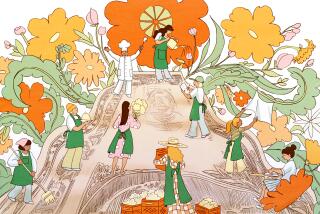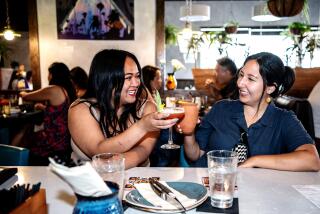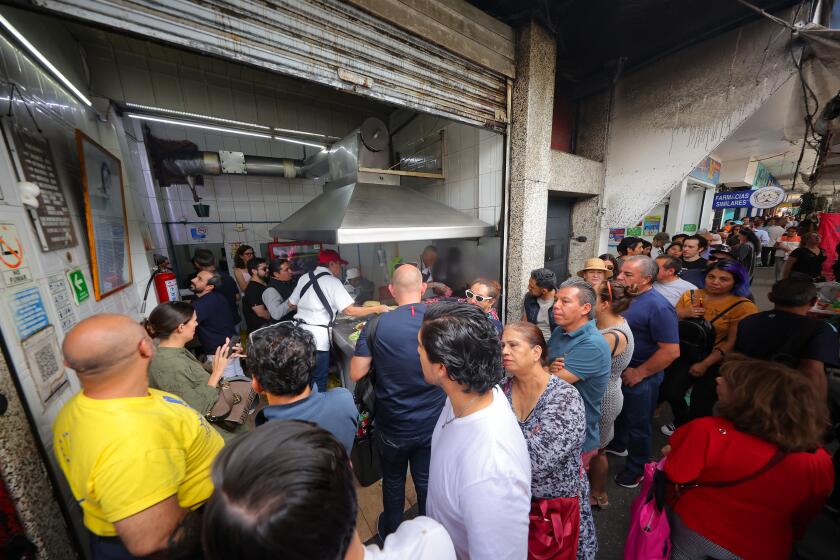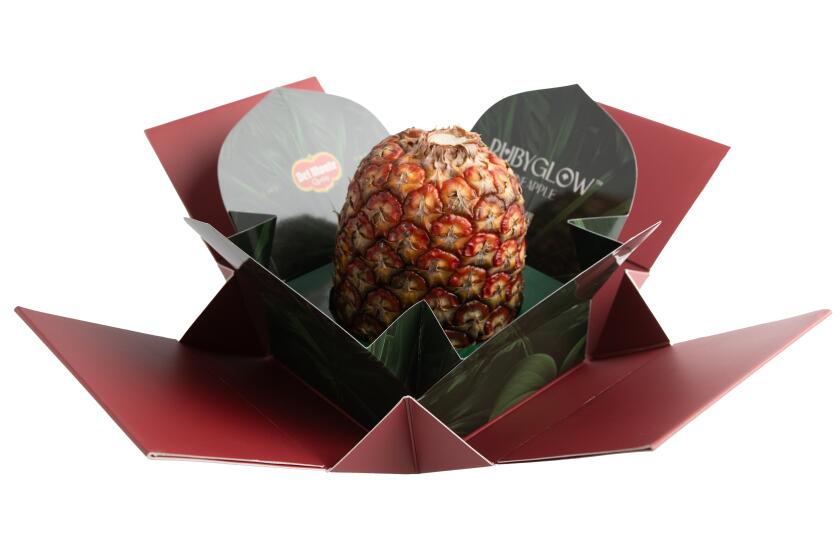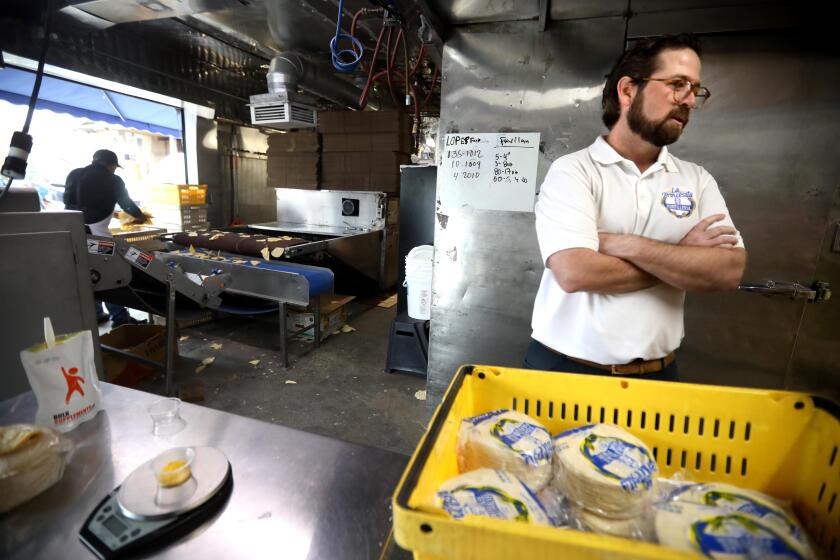At 75, wine giant Gallo is refining its palate
When Liu Lan entertains clients at her Shanghai cosmetics shop, she pulls out a jug of Gallo’s Carlo Rossi red wine.
“The taste is fresh and it’s easy to get used to,” said Liu, 32, who thinks the big bottle “looks special, different from other wines.”
The cosmetics shop in crowded Shanghai represents just how much has changed since Ernest and Julio Gallo founded E.& J. Gallo Winery in an industrial section of rural Modesto after Prohibition ended in 1933.
With annual sales of $3.5 billion -- about 70 million cases of wine -- Gallo is the nation’s largest winemaker. One out of every five glasses of wine drunk in America is a Gallo wine.
Gallo brands are sold in 90 countries including much of Europe, and the company brings foreign wine to the U.S.: Malbec from the mountains of Argentina, Chianti from Tuscany, Sauvignon Blanc from New Zealand, Shiraz from South Eastern Australia and Pinotage from Swartland, South Africa.
“We can compete very well with anywhere in the world,” said Joseph Gallo in a rare interview. He is the current chief executive and son of Ernest.
And as successive generations of Gallos take over running the business -- 15 family members work for the company -- it’s clear they plan to compete anywhere in the world.
As the company turns 75 this year amid public and private festivities, outsiders say that the Gallo family has gained a measure of peace from the tensions and tragedies that have chased it through the generations. Over the years, the Gallos have had to overcome bitter divisions and even a suspected murder-suicide.
The roots of the family’s wine tradition trace back to Giuseppe Gallo and Assunta Bianco, Italian immigrants who called themselves Joe and Susie after coming to the United States.
Although their sons Ernest and Julio claimed to have learned how to make wine from library books, their first exposure to the business was probably in the Bianco winery that Susie’s father owned in Hanford, Calif.
Joe and Susie had an unhappy marriage. In 1933, Joe Gallo apparently shot and killed Susie and then himself, according to Ellen Hawkes, author of “Blood and Wine: The Unauthorized Story of the Gallo Wine Empire.”
That was the same year Ernest and Julio started their winery in Modesto.
Divisions also plagued the brothers.
Joe, the youngest, left the business and became a farmer and cheese maker, only to be sued later by his older brothers over the use of the Gallo name on a line of cheeses. Joe sued back, claiming they cheated him out of a third of what was by now a wine empire. A court determined that the older brothers had the legal right to the Gallo name and all of the company.
As it grew, Gallo became almost as well known for labor disputes as it was for its wines.
“We have had a hot-and-cold relationship with Gallo going back to the 1960s,” said Arturo Rodriguez, president of the United Farm Workers of America.
After decades of often-bitter battles, Gallo and the UFW now work together again. Their long-standing fight, which included a labor-led boycott of the company that ended in 1978, “caused Gallo problems that there still is a residue of today,” said Modesto native David Runsten, now executive director of the Community Alliance with Family Farmers in Davis, Calif.
Some consumers still avoid Gallo-labeled wines because of a lasting and vague sense that the company is anti-union. It is ironic, Runsten noted, that some of those same people purchase Gallo wines not realizing that Red Bicyclette, MacMurray Ranch, Napa Valley Vineyards and Rancho Zabaco are all Gallo products.
Despite its union battles, Gallo is not a particularly politically conservative business. It has contributed nearly $3 million to various state campaigns since 1998, handing out money to Democrats over Republicans by a 2-to-1 margin, according to data from the National Institute on Money in State Politics, which tracks political contributions on its website at www .followthemoney.org.
For decades the company reflected the personalities of Ernest and Julio, insular and conservative businessmen. Now it is starting to open up.
The second generation of Gallos running the business has become particularly adept at spotting opportunities and taking advantage of them, said Jon Fredrikson, a Woodside, Calif., wine industry analyst.
Gallo grew up on selling cheap, often sweet wines such as Hearty Burgundy, Bartles & Jaymes, Ripple and Thunderbird. Its bestseller is still Carlo Rossi, the red jug wine that Liu likes to drink in Shanghai.
Though Rossi remains a good business, it’s not where Gallo is headed. The company is “putting enormous emphasis” on premium wines compared with the jug brands, Joseph Gallo said. “That is where the future is.”
Gallo trolls for well-known wine brands, gobbles them up and grows them. Such old-line names as Mirassou, Louis M. Martini and Bridlewood Estate Winery are now among the 60 wine labels Gallo owns.
“They have really changed their stripes and become much more aggressive,” said Frank Walters, an analyst at Impact, a beverage-industry trade journal.
So far it is a strategy that has worked.
“Gallo is still the biggest wine company in the U.S. and by far the most profitable,” Fredrikson said. “There is almost no waste in that company. They have a product for every grape.”
It helps that Gallo is a family company that doesn’t have to answer to the quarterly profit dictates of Wall Street, said James Lapsley, a UC Davis wine economist and historian.
That’s paid dividends for Gallo and California’s wine industry.
“Gallo was often the first California-labeled wine people ever tasted,” Lapsley said.
The company is all about being big, efficient and maintaining a cost structure that can compete with winemakers anywhere in the world, Joseph Gallo said as he walked through the massive glass plant on the company’s 350-acre campus in this San Joaquin Valley farming and food processing town.
Gallo is planning an expansion of the facility -- already the largest glass factory in the western United States -- that will boost its capacity to 1 billion bottles a year.
Gallo controls virtually the entire process from the fermenting of the grape juice to the manufacture of the cork that closes the bottle.
Nearby, dozens of towering white tanks store 93 million gallons of wine. And that’s just a fraction of Gallo’s storage. Its giant winery 30 miles south in Livingston holds 157 million gallons.
The company also has a large winery in Sonoma County and several other smaller facilities in other important wine regions, including Napa Valley and the Santa Ynez Valley.
Despite the family’s checkered history, the current three generations of family members at the winery appear “to work together pretty well. There’s not a feeling in the industry that there are problems,” said Joseph Ciatti, a longtime California wine broker who now heads Vintage Wine Trust, a real estate investment trust that focuses on wine properties.
As with all large, family-owned businesses, the Gallos risk that members of a younger generation might push for a sale or financial restructuring so they can cash out. There are 20 cousins in the third generation, and just nine work for the company.
Forbes magazine estimates that the Gallo family is worth about $1.3 billion. The family also is one of the state’s largest vineyard holders, owning more than 14,000 acres.
“We need to keep the family involved and connected to the business as we get generations away from the founders,” said Chris Gallo, a grandson of Ernest who is a manager in the winery’s import business. “We need to be able to pass down to future generations that this is our land and this is how we make wine.”
--
Times staff writer Don Lee in Shanghai contributed to this report.
--
(BEGIN TEXT OF INFOBOX)
Key dates in the history of Gallo
1933: With Prohibition ending, brothers Ernest and Julio Gallo found E. & J. Gallo Winery in Modesto.
1942: The company expands by buying 2,000 acres of land in Livingston, Calif.
1960s: Rapid growth helps Gallo become the largest winery in the U.S.
1972: Carlo Rossi, Gallo’s first nationally distributed brand, is first produced.
1973: After losing representation of laborers at the winery, the United Farm Workers launches a five-year boycott of Gallo wines.
1984: The company introduces Bartles & Jaymes wine coolers.
1986: Ernest and Julio Gallo sue younger brother Joseph Gallo over his use of the family name in marketing cheese.
1989: The older brothers win the exclusive right to use the Gallo name.
1993: Julio Gallo, 82, is killed in a Jeep accident on the family ranch.
2007: Ernest Gallo dies at age 97, two weeks after brother Joseph dies at 87.
2008: The company reaches its 75th year as a family-owned winery.
Sources: E.& J. Gallo Winery
, Times research
More to Read
Eat your way across L.A.
Get our weekly Tasting Notes newsletter for reviews, news and more.
You may occasionally receive promotional content from the Los Angeles Times.
